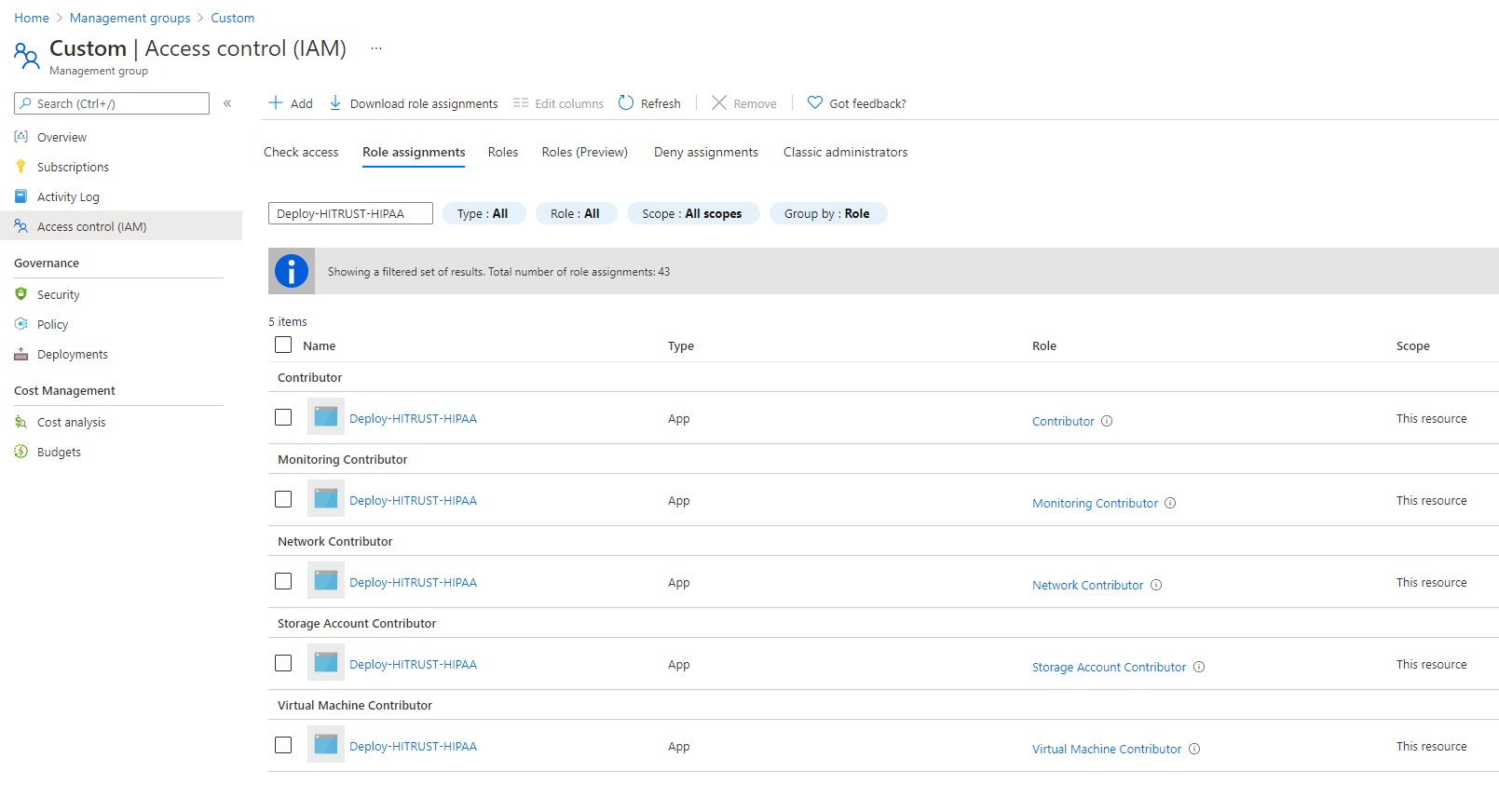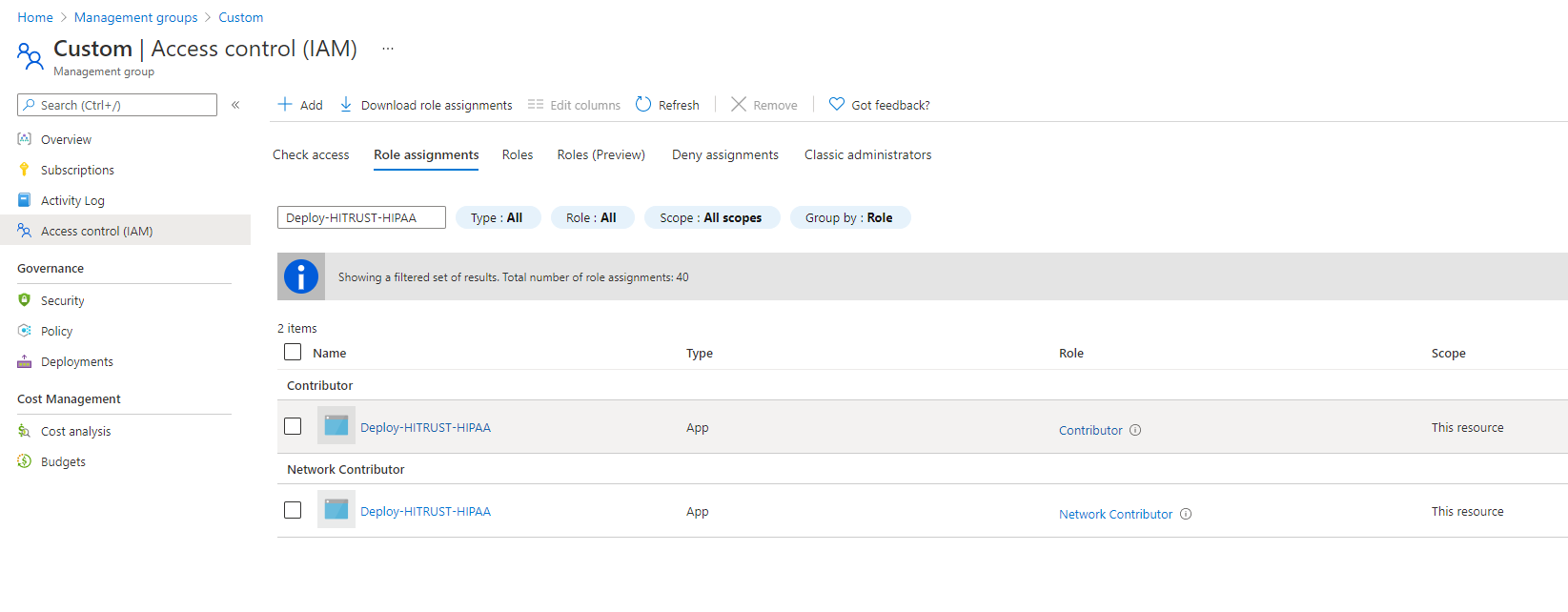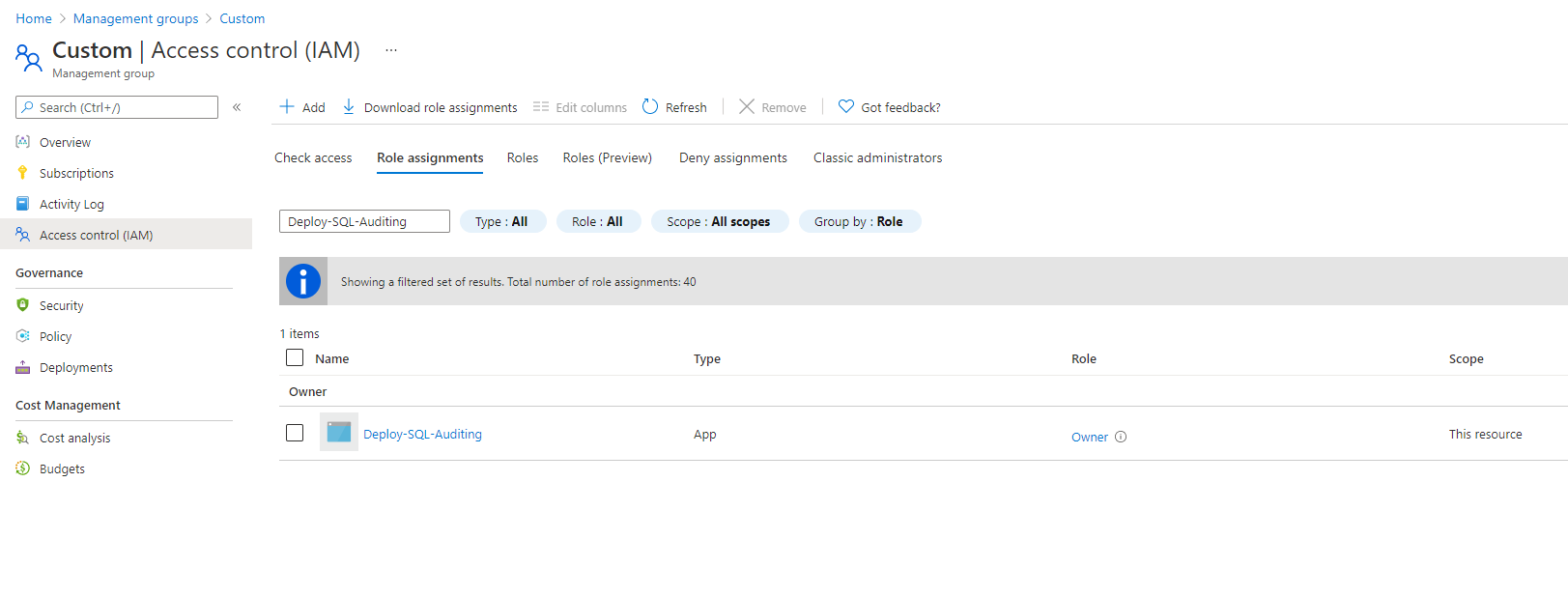-
Notifications
You must be signed in to change notification settings - Fork 579
[Examples] Override Module Role Assignments
This page describes how to deploy your Azure landing zone with a custom configuration, including guidance on how to override the dynamically generated Role Assignments for a specific Policy Assignment with Managed Identity.
NOTE: This feature is available from version 0.2.2.
We will use the Deploy-HITRUST-HIPAA and Deploy-SQL-Auditing policy assignments as an example.
On deployment, the module will auto-generate the role assignments necessary for any Policy Assignment when a Managed Identity is required to support policies using Modify or DeployIfNotExists effects.
-
For
Deploy-HITRUST-HIPAAthe module will generate 5 role assignments:
-
For
Deploy-SQL-Auditingthe module will generate 2 role assignments:
We will update the built-in configuration following these steps:
-
Create the policy assignment definitions
Deploy-HITRUST-HIPAAandDeploy-SQL-Auditing -
Create the custom archetype definition
customer_online -
Override the dynamically generated Role Assignments for
Deploy-HITRUST-HIPAAandDeploy-SQL-AuditingPolicy Assignments in a custom Landing Zone Management Group. -
Enable the role assignment override with
custom_policy_roles
IMPORTANT: Ensure the module version is set to the latest, and don't forget to run
terraform initif upgrading to a later version of the module..
To make the code easier to maintain when extending your configuration, we recommend splitting the root module into multiple files. For the purpose of this example, we use the following:
- terraform.tf
- variables.tf
- main.tf
- lib/policy_assignments/policy_assignment_dhh_policy_set_definition.json
- lib/policy_assignments/policy_assignment_dsa_policy_set_definition.json
- lib/archetype_definitions/archetype_definition_customer_online.json
The terraform.tf file is used to set the provider configuration, including pinning to a specific version (or range of versions) for the AzureRM Provider. For production use, we recommend pinning to a specific version, and not using ranges.
# Configure Terraform to set the required AzureRM provider
# version and features{} block.
terraform {
required_providers {
azurerm = {
source = "hashicorp/azurerm"
version = "~> 3.107"
}
}
}
provider "azurerm" {
features {}
}The variables.tf file is used to declare a couple of example variables which are used to customize deployment of this root module. Defaults are provided for simplicity, but these should be replaced or over-ridden with values suitable for your environment.
# Use variables to customize the deployment
variable "root_id" {
type = string
default = "myorg"
}
variable "root_name" {
type = string
default = "My Organization"
}The main.tf file contains the azurerm_client_config resource, which is used to determine the Tenant ID from your user connection to Azure. This is used to ensure the deployment will target your Tenant Root Group by default.
It also contains the module declaration for this module, containing a number of customizations as needed to meet the specification defined in the overview above. The custom_policy_roles is explained later in this example.
To allow the declaration of custom templates, you must create a custom library folder within the root module and include the path to this folder using the library_path variable within the module configuration. In our example, the directory is /lib.
NOTE: To learn more about module configuration using input variables, please refer to the Module Variables documentation.
# Get the current client configuration from the AzureRM provider.
# This is used to populate the root_parent_id variable with the
# current Tenant ID used as the ID for the "Tenant Root Group"
# Management Group.
data "azurerm_client_config" "core" {}
# Declare the Azure landing zones Terraform module
# and provide a base configuration.
module "enterprise_scale" {
source = "Azure/caf-enterprise-scale/azurerm"
version = "<version>" # change this to your desired version, https://www.terraform.io/language/expressions/version-constraints
default_location = "<YOUR_LOCATION>"
providers = {
azurerm = azurerm
azurerm.connectivity = azurerm
azurerm.management = azurerm
}
root_parent_id = data.azurerm_client_config.core.tenant_id
root_id = var.root_id
root_name = var.root_name
library_path = "${path.root}/lib"
custom_policy_roles = {
"/providers/Microsoft.Authorization/policySetDefinitions/a169a624-5599-4385-a696-c8d643089fab" = [
"/providers/Microsoft.Authorization/roleDefinitions/b24988ac-6180-42a0-ab88-20f7382dd24c",
"/providers/Microsoft.Authorization/roleDefinitions/4d97b98b-1d4f-4787-a291-c67834d212e7"
],
"/providers/Microsoft.Authorization/policyDefinitions/f4c68484-132f-41f9-9b6d-3e4b1cb55036" = [
"/providers/Microsoft.Authorization/roleDefinitions/8e3af657-a8ff-443c-a75c-2fe8c4bcb635"
]
}
custom_landing_zones = {
"${var.root_id}-customer-corp" = {
display_name = "Custom"
parent_management_group_id = "${var.root_id}-landing-zones"
subscription_ids = []
archetype_config = {
archetype_id = "customer_online"
parameters = {
Deploy-HITRUST-HIPAA = {
CertificateThumbprints = jsonencode("")
DeployDiagnosticSettingsforNetworkSecurityGroupsrgName = jsonencode("true")
DeployDiagnosticSettingsforNetworkSecurityGroupsstoragePrefix = jsonencode(var.root_id)
installedApplicationsOnWindowsVM = jsonencode("")
},
Deploy-SQL-Auditing = {
retentionDays = jsonencode("10")
storageAccountsResourceGroup = jsonencode("")
}
}
access_control = {}
}
}
}
}In the /lib directory create a policy_assignments subdirectory.
In the subdirectory policy_assignments create a policy_assignment_dhh_policy_set_definition.json file. This files contains the Policy Assignment definition for Deploy-HITRUST-HIPAA
{
"name": "Deploy-HITRUST-HIPAA",
"type": "Microsoft.Authorization/policyAssignments",
"apiVersion": "2019-09-01",
"properties": {
"description": "This assignment includes audit and virtual machine extension deployment policies that address a subset of HITRUST/HIPAA controls. Additional policies will be added in upcoming releases. For more information, visit https://aka.ms/hipaa-blueprint.",
"displayName": "Assign policies for HITRUST and HIPAA controls",
"notScopes": [],
"parameters": {
"installedApplicationsOnWindowsVM": {
"value": null
},
"DeployDiagnosticSettingsforNetworkSecurityGroupsstoragePrefix": {
"value": null
},
"DeployDiagnosticSettingsforNetworkSecurityGroupsrgName": {
"value": null
},
"CertificateThumbprints": {
"value": null
}
},
"policyDefinitionId": "/providers/Microsoft.Authorization/policySetDefinitions/a169a624-5599-4385-a696-c8d643089fab",
"nonComplianceMessages": [
{
"message": "HITRUST/HIPAA controls audit and virtual machine extensions {enforcementMode} be deployed."
}
],
"scope": "${current_scope_resource_id}"
},
"location": "${default_location}",
"identity": {
"type": "SystemAssigned"
}
}In the subdirectory policy_assignments create a policy_assignment_dsa_policy_set_definition.json file. This files contains the Policy Assignment definition for Deploy-SQL-Auditing
{
"name": "Deploy-SQL-Auditing",
"type": "Microsoft.Authorization/policyAssignments",
"apiVersion": "2019-09-01",
"properties": {
"description": "Deploy Auditing on SQL servers.",
"displayName": "Deploy Auditing on SQL servers",
"notScopes": [],
"parameters": {
"retentionDays": {
"value": null
},
"storageAccountsResourceGroup": {
"value": null
}
},
"policyDefinitionId": "/providers/Microsoft.Authorization/policyDefinitions/f4c68484-132f-41f9-9b6d-3e4b1cb55036",
"nonComplianceMessages": [
{
"message": "SQL auditing {enforcementMode} be configured."
}
],
"scope": "${current_scope_resource_id}"
},
"location": "${default_location}",
"identity": {
"type": "SystemAssigned"
}
}IMPORTANT: Please ensure you create this file in the
/libdirectory within your root module.
In the /lib directory create an archetype_definitions subdirectory.
In the subdirectory archetype_definitions create an archetype_definition_customer_online.json file. This file contains a custom "archetype definition" including the creation of Policy Assignments for Deploy-HITRUST-HIPAA and Deploy-SQL-Auditing
{
"customer_online": {
"policy_assignments": ["Deploy-HITRUST-HIPAA", "Deploy-SQL-Auditing"],
"policy_definitions": [],
"policy_set_definitions": [],
"role_definitions": [],
"archetype_config": {
"parameters": {},
"access_control": {}
}
}
}To map a Role Definition against the Policy Assignments we need to assign the role definition id(s) to the policy definition id.
This is the definition of the variable custom_policy_roles and the theoretical expected values:
custom_policy_roles = {
policy_definition_resource_id_1 = [
"role_definition_resource_id_1",
"role_definition_resource_id_2",
]
policy_definition_resource_id_2 = [
"role_definition_resource_id_1",
]
}For this example thecustom_policy_roles is this:
custom_policy_roles = {
"/providers/Microsoft.Authorization/policySetDefinitions/a169a624-5599-4385-a696-c8d643089fab" = [
"/providers/Microsoft.Authorization/roleDefinitions/b24988ac-6180-42a0-ab88-20f7382dd24c",
"/providers/Microsoft.Authorization/roleDefinitions/4d97b98b-1d4f-4787-a291-c67834d212e7"
],
"/providers/Microsoft.Authorization/policyDefinitions/f4c68484-132f-41f9-9b6d-3e4b1cb55036" = [
"/providers/Microsoft.Authorization/roleDefinitions/8e3af657-a8ff-443c-a75c-2fe8c4bcb635"
]
}

You have successfully overridden the built-in role definitions using custom_policy_roles for your Azure landing zone.
This wiki is being actively developed
If you discover any documentation bugs or would like to request new content, please raise them as an issue or feel free to contribute to the wiki via a pull request. The wiki docs are located in the repository in the docs/wiki/ folder.
- Home
- User guide
- Video guides
-
Examples
- Level 100
- Level 200
-
Level 300
- Deploy multi region networking with custom settings (Hub and Spoke)
- Deploy multi region networking with custom settings (Virtual WAN)
- Deploy with Zero Trust network principles (Hub and Spoke)
- Deploy identity resources with custom settings
- Deploy management resources with custom settings
- Expand built-in archetype definitions
- Create custom policies, initiatives and assignments
- Override module role assignments
- Control policy enforcement mode
- Policy assignments with user assigned managed identities
- Level 400
- Frequently Asked Questions
- Troubleshooting
- Contributing
